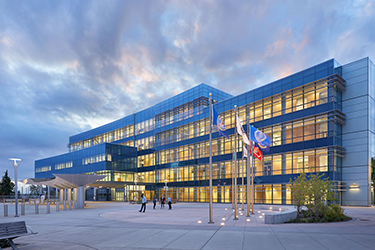|
Subscribe / Renew |
|
|
Contact Us |
|
| ► Subscribe to our Free Weekly Newsletter | |
| home | Welcome, sign in or click here to subscribe. | login |
Construction
| |
 |
July 29, 2021
Best practices in health care development and delivery
Clark Construction

Rechnitz
|

Mulvanny
|
Health care facilities are inherently complex. Successfully designing, constructing and delivering these vital community assets requires not only technical engineering expertise, but a comprehensive understanding of a diverse range of stakeholder needs and priorities. As builders, we must be hyper-focused on delivering highly sophisticated and efficient facilities that serve the needs of patients, physicians, clinical staff and the overall community long into the future.
Delivering a facility that operates seamlessly and enables the health professionals to provide the highest level of patient care requires a collaborative approach with key hospital leaders and end-users to understand their needs and priorities. Integrated project delivery fosters early collaboration among the builder, designer, engineers, select trade partners, the owner and other essential stakeholders to ensure the best possible result.
An approach grounded in proven processes and methodologies is imperative. But having the tools and experience at our disposal aren’t the only keys to success; flexibility and adaptability are also crucial as no two projects are alike. With that in mind, here are four best practices in project development and delivery that will help drive collaboration, informed decision making and the certainty of a successful project outcome:
LEAD WITH HUMILITY
Humility as your first action is incredibly important, especially in health care design and construction. Understanding that you are not the authority on all things and practicing active listening are essential to delivering a facility that achieves the end-users’ goals and serves the long-term needs of the community. From doctors to the chief financial officer, the clinical resource nurse and IT professionals, there are traditionally more stakeholders involved in health care projects than we see in other product types. These constituents all bring valued perspectives that carry equal weight and authority and are essential to designing a modern, efficient and highly functional medical facility.
TRANSPARENT COST DETAILS
It is difficult for an integrated team to do their best work with little visibility into the project’s budget. Providing detailed budget reports and analysis adds transparency, reduces risk and protects everyone in the long run. Through a shared cost model, we are able to provide complete transparency into how decisions affect the project’s budget in real time, which helps stakeholders prioritize their needs and wants. Creating a short and frequent feedback loop enables everyone involved to make informed decisions and safeguards against cost or schedule impacts. While the PDCA (plan do check adjust) model is intensive, and requires resources, the investment yields significant dividends that far outweigh the cost.
Recently, during a weekly budget review meeting on a local project, our team discovered a major jump in cost due to supply chain disruption and material availability. Because of the budgeting process our team established, this increase was identified early and resolved through a quick huddle with the project architect and engineers, bringing the project’s budget back in line. Without weekly cost reporting, the budget increase would not have been discovered until a milestone review, making adjustments far more complicated. Developing and leveraging a weekly dashboard to share real-time budget feedback is also beneficial and enables project leaders to bring forward potential value-added recommendations, identify cost efficiencies, and, at the end of the day, deliver a fully optimize health care facility.
INFORMED DECISIONS
Thousands of decisions are made throughout the design and development phase of any project. Having a thorough understanding of stakeholder priorities and “choosing by advantages” ensures a facility is best suited to meet the long-term needs of myriad constituents. Every facet of a project must be evaluated — from the flooring materials to the paving in the parking lot to the landscaping options — to enable the owner to better prioritize needs and wants and make informed decisions about their future facility.
This exercise isn’t solely designed to cut costs but rather to maximize value and ensure the facility is designed to serve the needs of the health system. Starting with the minimum requirements, seek to understand the cost advantage, the life cycle advantage, the efficient advantage, and then highlight the possible advantages of exceeding the mandated criteria. Through this approach, we can distill complicated information in a manner that enables a large body of authority to understand it and gain consensus.
LEVERAGE DIGITAL INSIGHTS
Starting each project with a full understanding of the site conditions provides actionable insights that help eliminate risk and ensure a smooth start to construction. Leveraging Clark’s digital construction affiliate Coda, we conduct an underground investigation of risk, which includes different data points of the site, such as test pits, site surveys, historical soil reports, excavation and water tables, and convert that information into a multi-dimensional model to analyze the site. The data collected during this process enables us to confirm knowns and unknowns, adapt to existing conditions, and transition into construction with confidence.
Laser scanning technology is another means to gain insights and achieve greater certainty on health care facility renovation or expansion projects. This tool provides us with a detailed understanding of existing conditions, such as the location of columns, ducts, slabs and other building elements, and how they will interface with new construction. By running a series of computational scripts to check the design documents and virtual project model for integrity issues, we can further mitigate the risk of design or code compliance issues.
Through these and other technology solutions, we can gain actionable insights at the earliest stage of project development, eliminate potential risks and achieve cross discipline alignment, all before construction begins.
In conclusion, building environments that aid the healing and wellness process are part of a region’s infrastructure. Working in partnership with private health care systems, academic medical centers and public providers to build hospital campuses, behavior health centers and research facilities each require very specific insights.
All health care projects are innately complex, but by addressing challenges early, and head on, with humility, transparency, insights, experience, and, most importantly collaboration, we can achieve exceptional outcomes. This is the future of health care.
Michael Rechnitz, project executive, and Ellen Mulvanny, senior design manager, are responsible for leading Clark’s active design-build health care work in the Seattle market.
Other Stories:
- Aggregation will drive a new hybrid science space
- Alternative delivery benefits health care in Washington
- Next-gen health care: Building healthier communities, economies
- Micro hospitals offer the right prescription
- The shape-shifting needs of the health care industry
- How flexible design served OHSU during the pandemic
- The shifting need for design in health care services
- Evidence-based design improves dialysis treatment experience
- Compounding pharmacies provide community resource



